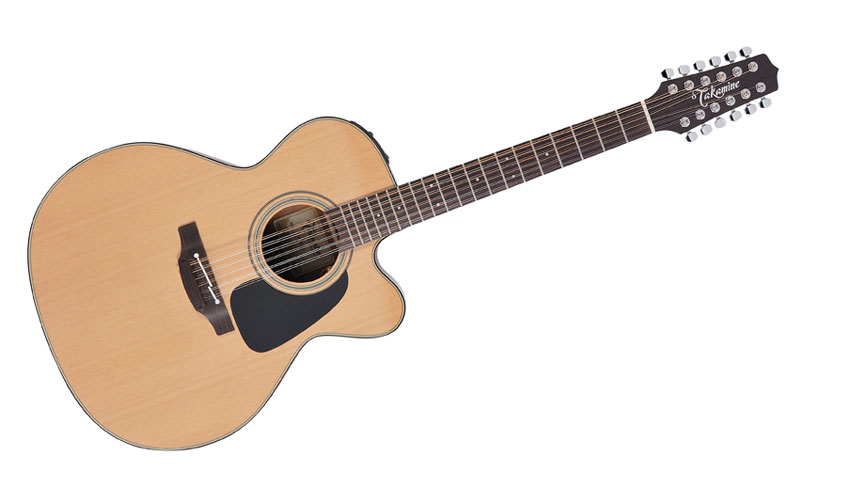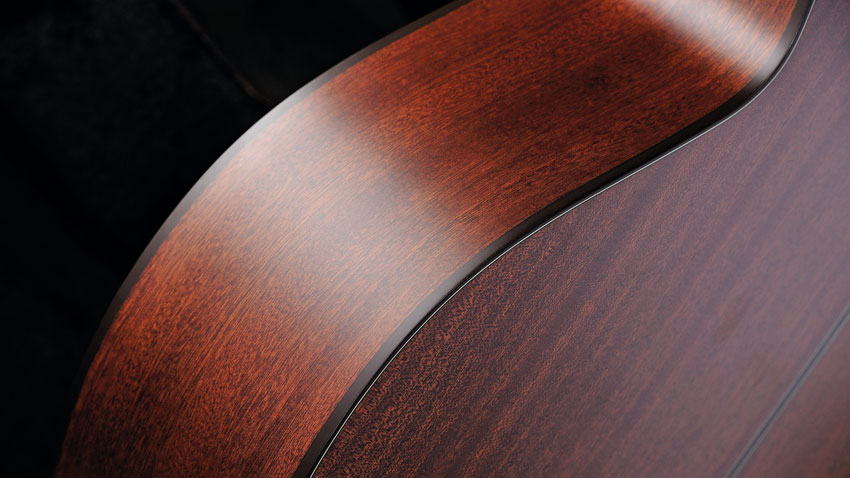MusicRadar Verdict
An excellent all-round 12-string electro that's worthy of a place on any £1k shortlist.
Pros
- +
Stylish look and feel. Tone and preamp.
Cons
- -
Minor quality-control issues on our sample.
MusicRadar's got your back

Takamine P1JC-12

Takamine P1JC-12 (finish)

Takamine P1JC-12 (bridge)
Takamine has been producing quality guitars since 1962. In addition to its annual Limited Edition models, the Japanese company is perhaps most noted for its stage-friendly electro acoustics.
"Takamine's various Pro Series ranges over recent years have become somewhat overwhelming, not to mention confusing. However, simplification is on its way"
For many of us, however, Takamine's various Japanese-made Pro Series ranges over recent years have become somewhat overwhelming, not to mention confusing. However, simplification is on its way. Brand new for Takamine's 50th year, we have the 1, 2 and 3 Pro Series guitars aimed at the gigging musician. Series 4, 5, 6 and 7 guitars are to follow.
The product names illustrate the simplification. P, for 'Pro Series' (a catch-all name that indicates Japanese-made guitars), is followed by the construction style: 1, 2 or 3. Then there's the shape: D (dreadnought), J (jumbo), M (orchestra model), N (NEX), F (FXC) and the smallest NY (New Yorker, parlour-style). Finally, a C is added for cutaway models, a 12 for 12-strings, while the sole nylon-string gets an additional N. So in the P1JC-12 (reviewed here), we've got a Pro Series 1 Jumbo 12-string with a cutaway.
It comes in a good-quality, Takamine-branded hardcase featuring a generous neck cradle, beneath which is a gigging-friendly interior compartment that will comfortably accomodate a strap, set of strings, spare battery, capo and basic tools.
Our review model features a pinless rosewood bridge. For anyone who's ever suffered the misfortune of a broken string onstage, pinless bridges allow a replacement to be fitted in super-quick time without the aid of any tools. The two-piece saddle is made from bone.
"The crucial power comes from Takamine's proprietary six-element Palathetic saddle pickup partnered by the CT4B II Cool Tube preamp"
The crucial power comes from Takamine's proprietary six-element Palathetic saddle pickup partnered by the CT4B II Cool Tube preamp. Placed just forward of the upper-bout shoulder, it's cleanly laid-out and easy to use mid-song.
The control panel offers three centre-indented EQ sliders - which control the low, mid and high frequencies with a +/- 5dB range - and a volume slider. A single push-button engages the tuner; push once to activate, push twice for muted tuning when amplified and a third time to switch off. The tuner is also capable of being calibrated to frequencies other than standard A440 and auto-shuts down after a few minutes if no signal is received.
Despite being a Series 1 guitar, the overall appearance and presentation of the P1JC-12 is impressive. The bookmatched cedar soundboard benefits from a high-gloss finish, and the binding to both the front and back of the body is a dark shade, giving the guitar a classy look overall.
Measuring bang-on 432mm (17 inches) at its widest, it's a beast of a guitar. Yet, despite its size, it remains a comfortable instrument to play, and is well balanced, whether played seated or with a strap. And our review model features a heavy-duty endpin jack, which screws directly into the wood and doubles up as a strap button.
We'd suggest that this type of jack is far more suitable than models where the inner barrel screws into an outer casing. So often, time and travel cause the jack to unscrew - a pet hate of ours.
There's also a pickguard, pearl dot fretboard markers and pearl dot inlays positioned at either end of the split saddle.
Overall, standards of build and presentation are good, with one little exception: one of the pearl dots inserted into the bridge hasn't been fitted particularly well. It sits proud and is a little rough feeling to the touch.
Sounds
"The P1JC-12 sings loud, with a dry, woody timbre. First-position chords are dispatched with a well-balanced tone and it sustains well"
The P1JC-12 sings loud, with a dry, woody timbre. First-position chords are dispatched with a well-balanced tone and it sustains well. Some jumbos can suffer from a 'mushy' low-end, but no such problems here: the P1JC- 12's low-end is tight and plump.
Pushing hard with a heavy-gauge pick does reveal the guitar's limits in terms of retaining tonal depth, but overall the P1JC-12 offers a very likeable and usable output. The CT4B II performs well - its frequency controls alter the tone enough to easily find a versatile range of acoustic sounds.
Our only niggle here was with the chromatic tuner, which had some difficulty in tracking the G and D octave strings for tuning. That aside, the P1JC-12 makes for an excellent stage-ready electro. It offers a strong electro output and, in a live band setting, we had no issues with holding the volume back to 80 per cent, then giving it full beans for solos.
Steve Harvey is senior content producer for Pro Sound News and also contributes to other Future brands. He has worked in the pro audio industry — as a touring musician as well as in live production, installed sound, and equipment sales and marketing — since November 1980.
“I called out to Mutt and said, ‘How about this?’... It was a complete fluke": How Def Leppard created a rock anthem - with a little bit of divine intervention
Baby Audio's Smooth Operator spectral balancing plugin goes pro
"It was ugly, like watching a divorce between four people. After a while, I had to get out": Beatles engineer Geoff Emerick on the recording of Abbey Road, track-by-track









